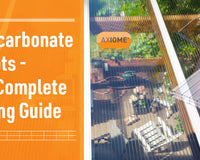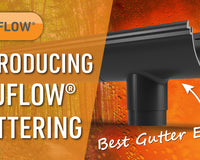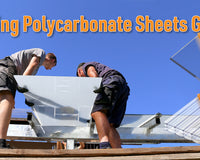So, you have installed your new clear polycarbonate roof panels and have noticed some water trapped inside the multiwall polycarbonate? This could be condensation and is an issue that is more common than you may think. However, the main reason for this is more often than not due to poor installation practices.
You may be asking, can I prevent condensation in Polycarbonate Roof Sheets? Well, there are a lot of factors to consider, and a lot of myths to dispel. The first point is that it is really important to do all you can to reduce the risk of condensation in polycarbonate roof panels.
Getting the job done right in the first place is key, however, if you have found condensation in polycarbonate roof panels there is a chance they could be saved! Read on and we will discuss the best installation practices and how to help prevent condensation in Polycarbonate roof panels. We will also discuss how to potentially save your polycarbonate sheets and remove any water in polycarbonate roof sheets.
Click the below links to jump to the relevant section:
What Is Condensation in Polycarbonate Sheets?
6 Main Factors That Can Lead to Condensation in Polycarbonate
How Can Polycarbonate Sheets be Affected by Condensation?
How Can I Prevent Water in Polycarbonate Roof Sheets?
Top Myths Dispelled About Condensation in Polycarbonate
Can I Get Condensation Out of Polycarbonate Sheets?
Can I Ignore Condensation in my Polycarbonate Sheet?
What if my Polycarbonate Conservatory Roof is Leaking?
What Is Condensation in Polycarbonate Sheets?
Condensation in twinwall polycarbonate sheets is caused by moisture getting inside the sheets. If small amounts of water, even as little as a single drip, get into the lower end of the polycarbonate sheets then it can turn into condensation. When the sun heats the water it evaporates into invisible vapour (like steam) and then later in the day when the sun sets and the polycarbonate sheet cools down. The vapour condenses on the surfaces within the twinwall polycarbonate sheets and forms tiny droplets that we know as condensation.
6 Main Factors That Can Lead to Condensation in Polycarbonate
- Drip trim not installed correctly onto polycarbonate panel.
- Poor quality drip trim used which can crack or warp
- No breathable filter tape installed or installed
- Filter tape and/or polycarbonate sheets damp before installation
- Polycarbonate sheets exposed to moisture
- Polycarbonate panels installed in poor weather conditions
How Can Polycarbonate Sheets be Affected by Condensation?
One or all of the factors listed above can cause condensation within the flutes or chambers of the polycarbonate roof sheet. Condensation within the polycarbonate roof sheet could appear as soon as they are installed, or may take time and appear over a few months or even years. This depends on several factors such as temperature, location, the pitch of the roof and also how bad the issue causing the condensation is. Temperature changes can cause any moisture to result in condensation.
An Anti-Dust Breather Tape is recommended as part of the installation process. This tape prevents dust and insects from entering the polycarbonate sheets to support a cleaner sheet for longer.
Along with the tape, it is also essential to cover the anti-dust tape on the sheets with a high-quality Aluminium Endstop Bar and seal the underside of the upper jaw of the Aluminium Endstop bar on to the polycarbonate sheets with a compatible silicone sealant. The Endstop Bar is designed to leave a small gap to ensure air circulation allowing the polycarbonate to breathe. The silicone used should be a low-modulus neutral-cure sealant to provide the best seal without any adverse effect on the polycarbonate sheets.
There are budget PVC drip trims available, however, these are not as robust as an Aluminium Endstop Bar. PVC can crack, move or twist allowing water ingress to the polycarbonate roof sheet.
Sometimes, Fixing Buttons for Polycarbonate Twinwall Sheets may also be required for your installation. These are designed with a foam insert that acts as a seal once the screw is fitted to the sheet. There is then a plastic cap which clicks in place to seal the fixing and preventing any water ingress. Whilst fixing buttons are handy for intermediate fixings they can cause challenges with condensation unless fitted perfectly, so if possible, use narrower spacing between glazing bars so that fixing buttons are not required.
How Can I prevent water in polycarbonate roof sheets?
They say prevention is better than the cure, so, ensuring that your sheets are installed correctly will almost certainly help stop trapped water in your polycarbonate roof. Due to the nature of multiwall polycarbonate roofing sheets being hollow, without careful installation, there is a high chance that condensation may form.
So, to save the concern on this, many people install Opal polycarbonate roof sheets. Opal Polycarbonate is like a tint which lets light in but obscures any view. This in turn means that you will not see any water vapour when compared to clear roof sheets. There are other advantages to Opal too, such as providing privacy from overlooking buildings and hiding any standard roof dirt from view.
As polycarbonate is hygroscopic it will absorb moisture from the air and it cannot be sealed 100% airtight. However, experience tells us that 99% of moisture within Polycarbonate roof sheets is caused by poor installation. Follow the below steps to reduce the risk and increase the longevity of your clear polycarbonate roof panels
Steps To Reduce The Risk of Condensation:
- Ensure that your polycarbonate roofing sheets are kept clean and completely dry before and during installation.
- Wait until you have a nice warm dry day for installing the polycarbonate panels
- Peel back the protective film to expose the open ends of the polycarbonate sheet
- Apply an anti-dust breather tape to all open ends of the sheets
- Apply a thin strip of Securbond LMN silicone to the upper and lower edge of the sheet at the edge of the anti-dust tape.
- Install a high-quality aluminium end-stop bar designed to leave a sufficient gap to allow the polycarbonate roofing panels to ‘breathe’.
These simple but effective steps can help stop water from getting inside the polycarbonate sheets and creating vapour which turns into condensation in the polycarbonate roofing sheets!
This video below on 'How To Install Polycarbonate Roofing Sheet Tape' shows you a practical demonstration of how some how some of the above steps are done.
Top Myths Dispelled About Condensation in Polycarbonate
- The majority of the time the presence of condensation is not due to the polycarbonate roof sheets leaking.
- If moisture appears inside the sheets, this is not due to the humidity of the room.
- Condensation does not form on the top of the polycarbonate roof panels
- Leaking polycarbonate roofs may not be leaking – quite often this water or vapour is condensation
Can I Get Condensation Out of Polycarbonate Sheets?
As mentioned earlier, prevention is key to stopping water from forming within the polycarbonate roof sheets. Once you have this issue, it can be very difficult, although not impossible, to save your sheets!
First of all, you will need to uninstall the polycarbonate roof sheet being careful not to cause any damage or scratches.
Once you have the sheet removed you will need to give it a good clean using plenty of warm soapy water and a soft lint-free cloth. Be careful some cleaning solutions can damage the polycarbonate and using an abrasive cloth can cause scratches to appear! Rinse your cloth often in plenty of water to prevent any dirt or grit from scratching the polycarbonate.
Next, you will need to let the sheet dry in a warm dry area – the polycarbonate roof sheet must be 100% completely dry before re-installing.
Once you are sure that all of the water vapour is gone, follow the steps mentioned above on how to re-install your polycarbonate roof sheets.
Can I Ignore Condensation in my Polycarbonate Sheet?
You may be wondering what is the problem if I ignore water vapour in multiwall polycarbonate sheets?
Ignoring the issue is probably not a good idea, over time moisture will result in the growth of algae and mould which will spread and leave your roof looking unsightly.
However, apart from being unsightly, mould, mildew, and algae will generally not cause any structural damage to the polycarbonate panels and are unlikely to affect the performance of the roof structure.
What if my Polycarbonate Conservatory Roof is Leaking?
Having checked the above, if you are certain that condensation is not the problem you may have a leaking polycarbonate roof. If you have dampness or water within the actual room, it may be due to poor ventilation and/or a high humidity level within the room. However, if the water is significant then you may have a leak in your actual polycarbonate roof.
Polycarbonate roof sheets are very robust, unless there has been a significant impact the leak is likely due to an installation issue.
To fix a leaking polycarbonate roof, follow the below steps:
- Check carefully to find the source of the leak. Find out where the water is getting in.
- Consider replacing the glazing bars with high-quality durable glazing bar systems which will last much longer and won't have issues with leaks
- You may want to also consider replacing the polycarbonate sheets to ensure that you start with clean and dry sheets to seal properly.
- Ensure that you follow a Glazing Bar Installation Guide so you don't miss any important steps.
- Make sure you protect the polycarbonate sheets from condensation as discussed earlier
Using great quality aluminium glazing bars and new polycarbonate sheets you should be able to create a roof that lasts for many years to come without any leaks.
If you need any further advice or assistance with your project our helpful teams are happy to help via our Live Chat service alternatively you can email shop@clearamber.com and we will provide all the support you need regarding helping prevent condensation in polycarbonate.
Place Your Order Today – Get Same Day Despatch, Free Returns & Flexible Payment!
At Clear Amber Shop you can have total peace of mind with:
- Get SWIFT Guaranteed Same Day Despatch for rapid delivery
- Return items within the scope of our NQS Returns Policy
- Spread or delay the payment by choosing our Flexible Payment Options
- Register your products for the Total Lifespan® Warranty
Our Teams are here to support you every step of the way – Talk Soon…
Related Blog Articles:
- Best 3 Roof Sheets for a Carport
- Best 3 Glazing Bars For Glass & Polycarbonate
- Can You Walk on Polycarbonate Roofs?















4 comments
neelaadritrueframe
This article on preventing condensation in polycarbonate roof sheets is a fantastic resource for anyone dealing with this issue. It provides clear and practical tips that are easy to follow. Thank you for sharing this valuable information!
Washing Pinecrest
Excuse me! You’ve been really helpful by providing us with this data. Advice on Roof Sheets is something I’ve been trying to find for a while now. I value what you’ve done. I really enjoy reading what you have to say, so please keep it up.
Anonymous
Thank you for your question Ray!
We have seen this done on a number of occasions and sometimes it proves to be successful. However, polycarbonate resin cannot be hermetically sealed which in simple terms means it can breathe. This means in turn that there is a risk of moisture within the air still getting inside the sheets, and condensation appearing. The risk is low, and if you did this on a dry day and when humidity is low then there’s a good chance you could be successful, we just can’t promise though.
Ray lock
Could I just seal the open ends with clear silicon to prevent condensation?